
Wet Felted Coin Purse and Free Pattern
Home » Blog » DIYs and Craft Projects » Fiber Crafts » Wet Felted Coin Purse and Free Pattern
-
Daniela Kretchmer
- Updated: Oct 27, 2023
- Accessory, Felting, Popular Posts, Wet Felting, Wool

Learn how to make a felted coin purse using wet felting and nuno felting techniques. There is also a free printable coin purse pattern to make it easy to get started making your wool purse. Additionally, I give instructions on how to attach a metal purse clasp.
Table of Contents
I got really into fiber arts and felting in 2020 so I’m excited to share the first felting project for the site. There will definitely be more to come, but I like this handmade felted coin purse because it’s small, which means it’s easier. When it comes to felting, the bigger the project means a lot more time spent getting it to actually felt and shrink. So this small coin pouch is a happy middle between being small, but also can make a great handmade gift.
Depending on the purse clasp you use, you can also keep it as a standalone coin pouch or as a small coin purse keychain.
If you’re new to wet felting, I highly recommend my ultimate guide to wet felting in which you learn the basics.
Note: Some links in this post may contain affiliate links, which means at no cost to you, I may earn a commission.

Free Printable Coin Purse Pattern
I have created a free printable coin purse pattern you can use for this felting project. Download below or from the shop. This is the actual resist pattern I use for my own felted coin purses. It is designed for 30-40% shrinkage and to work with a 3.3″ coin bag frame and kiss clasp.
Note: When printing, be sure to print without margins and at actual size. I have included a 1 inch ruler on the page so you can double check it printed correctly.
If you’d like to make your own resist, I’ve created a wool shrinkage calculator you can use. Simply input your shrinkage percentage and the final measurements you want after felting.

Download the Free Coin Purse Resist Pattern
We’re committed to your privacy. AB Crafty uses the information you provide to contact you about relevant content and products. You may unsubscribe from these communications at any time.

Materials for the Wet Felted Coin Purse
- Resist Material (this can be any flexible non-porous material. I personally like to use the Amazon packing material for this as well) – If you’ve never worked with a resist or made a 3D felted item, it’s what you use to make sure your item does not felt to itself.
- 0.5 oz of Wool Fiber (choose one color or multiple! I used purple and teal merino wool. Make sure whatever wool you use is NOT labelled as “SuperWash” – this is treated so that it doesn’t felt)
- Sari Silk Fabric (optional) – Amazon
- Silk Yarn (optional) – Amazon
- Coin Purse Clasp (I used a 3.3″ kiss clasp, but you can add a keychain to it to make it a felted coin purse keychain) – this is the one I used
- Embroidery Thread and Needle – Amazon
You can make the felted coin purse with just the wool, change purse clasp, and embroidery thread, but I like to embellish it. Actually, adding the extra silks, yarns, and fibers is probably my favorite part (you can even dye your own silk with candy to use for this project!). Therefore I’ve listed the items I used, but feel free to use whichever fibers and/or yarns you would like, or none at all.
Making this specific coin pouch, I was testing out some new sari silk scraps and silk yarn to see how they would felt. In general, I highly recommended making a sample for any wet felting project so you know how the items are going to turn out and understand how much it’s going to shrink. However, this time I figured I would just test them out by making a handmade purse.
Wet Felting Supplies You Will Also Need
How to Make the Wet Felted Coin Purse
If it’s your first time wet felting, I recommend my guide to wet felting so you can learn the basics and different techniques.
Video Instructions
Make the resist using the coin purse pattern
Download and print the free coin purse pattern (be sure to print it out full sized without margins). Cut the resist material according to the pattern.

Download the Free Coin Purse Resist Pattern
We’re committed to your privacy. AB Crafty uses the information you provide to contact you about relevant content and products. You may unsubscribe from these communications at any time.
Layer the wool fiber over the resist
Begin by cutting your resist to the size and shape you would like. You can still use the coin purse pattern if you use the same size clasp (3.3″ kiss clasp).
Place the large bubble wrap down and place your resist in the middle. Start by pulling off a small amount of fiber and laying it in one direction on top of the resist. Here are the fibers I recommend.

Tip: Try to keep the fibers flat and not clumped together by holding the main wool in your non-dominant hand and then using your palm of your dominent hand to lightly grasp some of the fibers and pull. If it’s difficult to pull, then bring your non domiment hand further away from the end of the fiber and try again. The fiber length (staple length) is probably longer than the distance between your hands so by widening that distance you’ll be able to grasp the fiber much easier.

Continue laying down fiber in the same direction across one side of the resist. Let a little bit of the fiber lay over the edge as you want some to wrap around the edge.
Feel free to play around with different colors of wool. One of the wool rovings I used was a blend of different teals and blues and then I added in some purple. You can also blend your own wool to use for this project – grab bags are great for this!
Tip: Keep the layer thin, you can always add more, but by keeping it light and even it will allow the fibers to more easily interlock and felt together.

After you have your first layer of wool, start laying down the fiber in a layer perpendicular to the first. So if you started your first layer going left and right, like I did, place the next layer facing up and down.
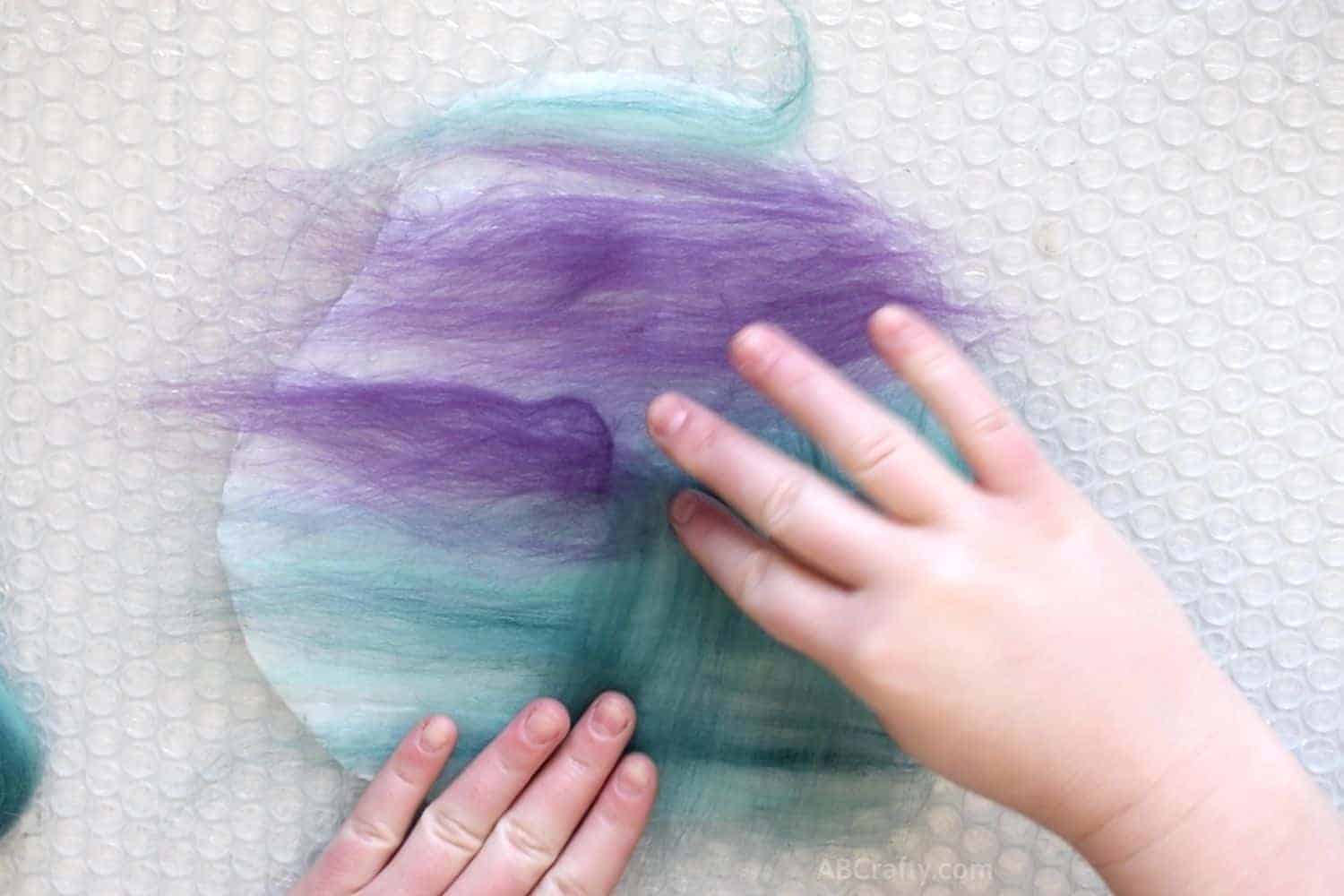
Just as with the first layer, let some of the edges and wisps hang over the edge of the resist.
If needed, cut the fiber in half or thirds to shorten it if you need just a little bit to fill in spots. If you do this, I do recommend mixing them up a bit and separating them so they’re not in a sharp straight line. You want them to nicely blend together with the other fiber.

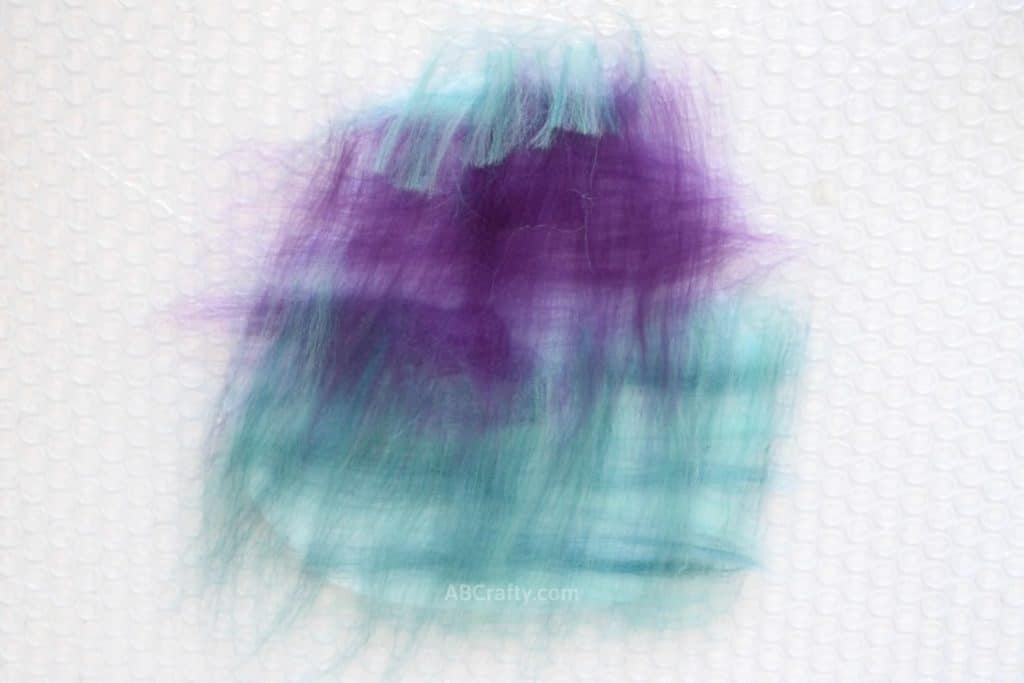
After you’ve completed your 2 perpendicular layers, take your mesh fabric and place it over the wool.
Then mix some olive oil soap into hot water. I like to do this by simply dropping the bar into the water and mixing it around for a bit.
Wet the wool with the soapy water – just enough to soak the fiber. You don’t want to make a pool on your table. I use a ball brause, but using a sponge works well, squeezing out a little bit of the soapy water at a time.

Use your hands to gently press the soapy water into the wool and push the air out.

After the wool fiber is all wet, grab one end, tucking in the fiber and carefully flip it over. As you flip it over, remove the mesh netting.
Once on the opposite side, go around the edge and pull the wisps towards the middle. Be sure that they’re pressed against the edge. If you don’t, it will felt against itself on the edge and you’ll have a crease along the edge.

After you’ve pulled all the wisps towards the center of the resist, start layering the wool on this side. Do the same process on this side as you did on the other side. Place the wool in the same direction that you started with on the first side and then add a second layer perpendicular to the first.
Again, make sure there are some ends of the fiber hanging off the edge.

Just as with the first side, cover it in the mesh fabric and add the soapy water. Again, gently press the water in and air out with your hands. Then flip it over and pull the wisps to the middle.
Next, add another two layers of wool that lay perpendicular to each other. This time, however, don’t have as much of the wool hanging off the edge of the sides will be too thick.

Do the same process as before – place the mesh over it all and add the soapy water. However, keep in mind since the wool under it is wet you likely won’t need to add too much more water. Press in the water and again, flip it over, and tuck in the wisps. Repeat the process on the other side.
Therefore in total you should have done four total layers of wool on each side, two layers at a time on each side.
Add the embellishments - sari silk scraps and silk yarn
Now you can add the embellishments or what some call “bling” fibers. For mine, I began with the cut pieces of sari silk scraps (like these). You can leave them as is or blend them into the fiber by placing additional pieces of fiber along the edge.
Tip: For thicker pieces of fabric or more difficult fiber that do not felt easily (eg. non-wool items such as silk), definitely add fiber along the edge or even across it. Although fiber from below may felt to it, it will be easier and more secure if you place additional wool on top.

After placing the sari silk scraps, I added rainbow silk yarn (like this), swirling it around. For this, since it’s very narrow, I didn’t add any fiber on top of it.
If anything I find there’s often too much fiber that migrates from underneath covering the add ons and bling fiber so I typically don’t add fiber on top. However, I learned for this one that the thicker sari silk definitely should have extra fiber placed around the edges to make sure it’s secure.
Tip: Let some of the embellishments hang off of the edge so that they can covered around to the other side. This way it’s seamless all the way around and doesn’t look like the coin bag has two separate sides.

Just as before with the fiber, cover everything with the mesh and wet the added silk scraps and yarn or other embellishments with the olive oil soap filled water.
Add additional elements to the other side and again, wet it out.
Once you’re happy with everything on what will be the change purse, it’s time to start felting.
Felt the wool
To start felting the wool, get your hands wet and soapy using the olive oil soap and VERY gently rub along the top of the mesh. The soap should allow your hands to glide right over. What you’re doing is creating a “skin” to the top of the wool that will keep everything in place.

After about a minute or so you should be able to start applying more pressure. Rub the fiber in a circular motion all over the top, continuing to push air out and the soap and water in.
Continue this process on both sides until the embellishments are staying in place.
Tip: As you apply pressure it’s a good idea to lift up the mesh to make sure the fiber and added elements are not sticking. If they are, that means you’re using too much pressure for the stage it’s in. Lighten up on the pressure and continue to check. As it gradually felts you’ll be able to be more aggressive.
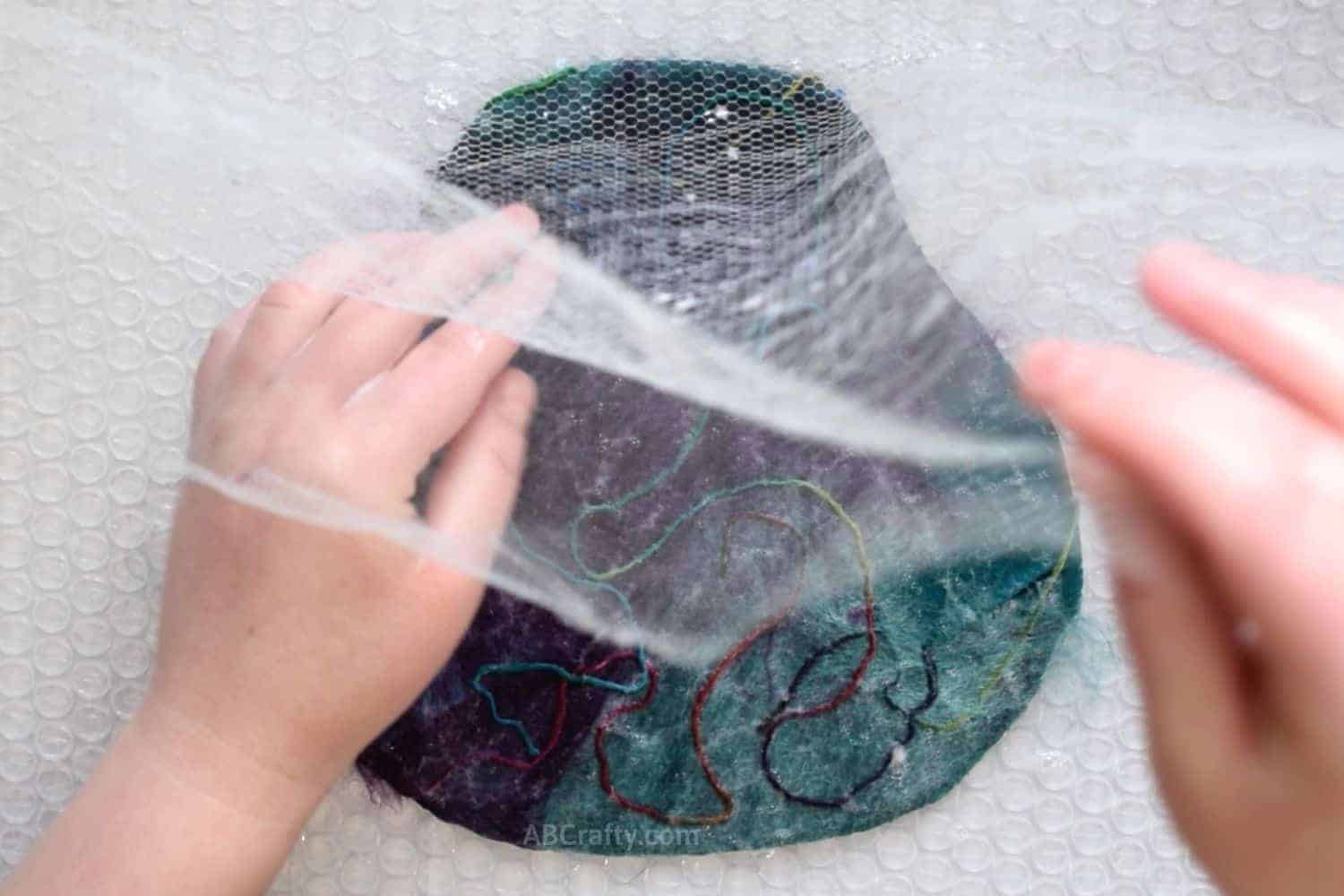
After you’ve felted the wool enough so that the yarn, silk, or other embellishments are staying, you can start the process of rolling.
To do this, keep the mesh over the project and place the pool noodle on top on one side of the bubble wrap you’ve been working on. Roll it all up around the pool noodle.
Tip: The reason you use the pool noodle here is because it’s still a soft and gentle material to allow for a gentler initial felting process. As you felt you want to start gentle and then get more aggressive to ensure an even felting of all of the fibers. If you’re too aggressive to soon, layers may felt to themselves rather than to each other.
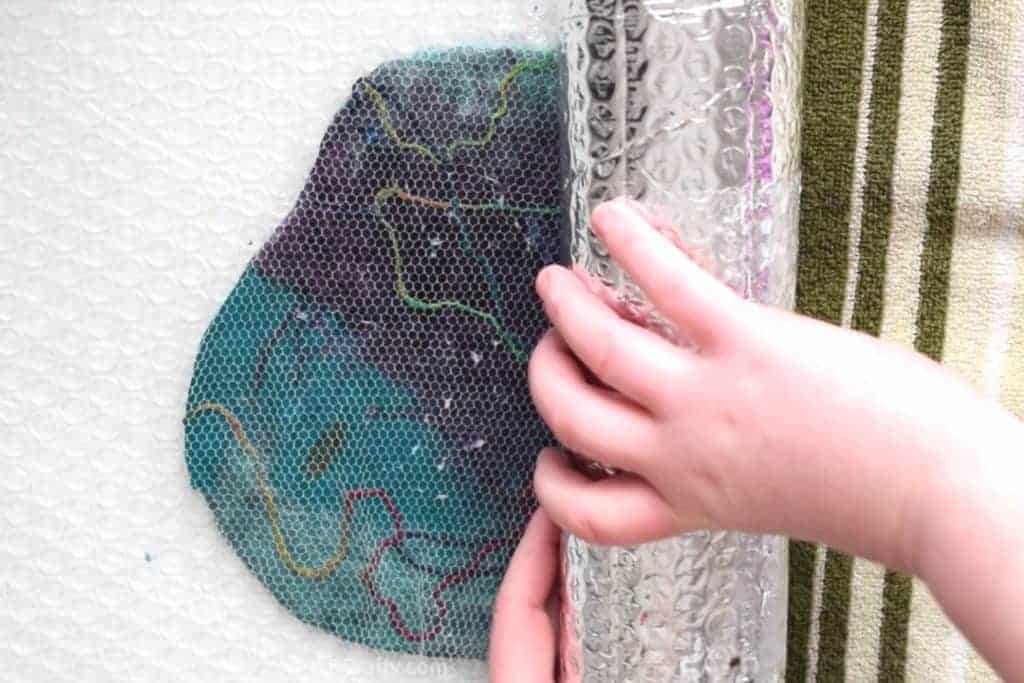
Once rolled up, wrap it in a towel so it’s easier to work with.
Now you’re going to roll it on all sides and from all sides. I work in groups of 100. I start rolling it 25 times, just the length of my hands. Then I give the “log” a quarter turn and roll another 25 times. I do this two more times so that its been rolled 100 times in total and evenly all around.
Then unroll it and place the pool noodle on the other side of the bubble wrap. Repeat the same rolling process. Then place the pool noodle at the bottom and roll it from the bottom. Unroll it and roll from the top.
Tip: Each time you unwrap it, check the mesh to make sure it’s not sticking. If it is, roll more lightly until the mesh isn’t sticking to the fiber.

You should now have rolled it from all four sides, 100 times on each side.
Next, flip the lightly felted coin purse over and do the same rolling process from all 4 sides.
At this point it is likely felted enough to be more aggressive. You can also check it by doing the “pinch test.” Lightly pinch the fibers. If they lift together as one then it’s ready. If the fibers are still separate then you need to roll more.

Once your felt passes the pinch test you can start rolling it around just the pool noodle without the bubble wrap. I recommend still having the mesh just in case so it doesn’t felt to itself. Be sure to keep doing the quarter turns and rolling from all sides and flipping it over.
When you start feeling the coin bag shrink down and the resist becoming too small, remove the resist. To do so, cut along the small top curve. If you want to use the coin purse pattern again, be careful to not cut the resist.
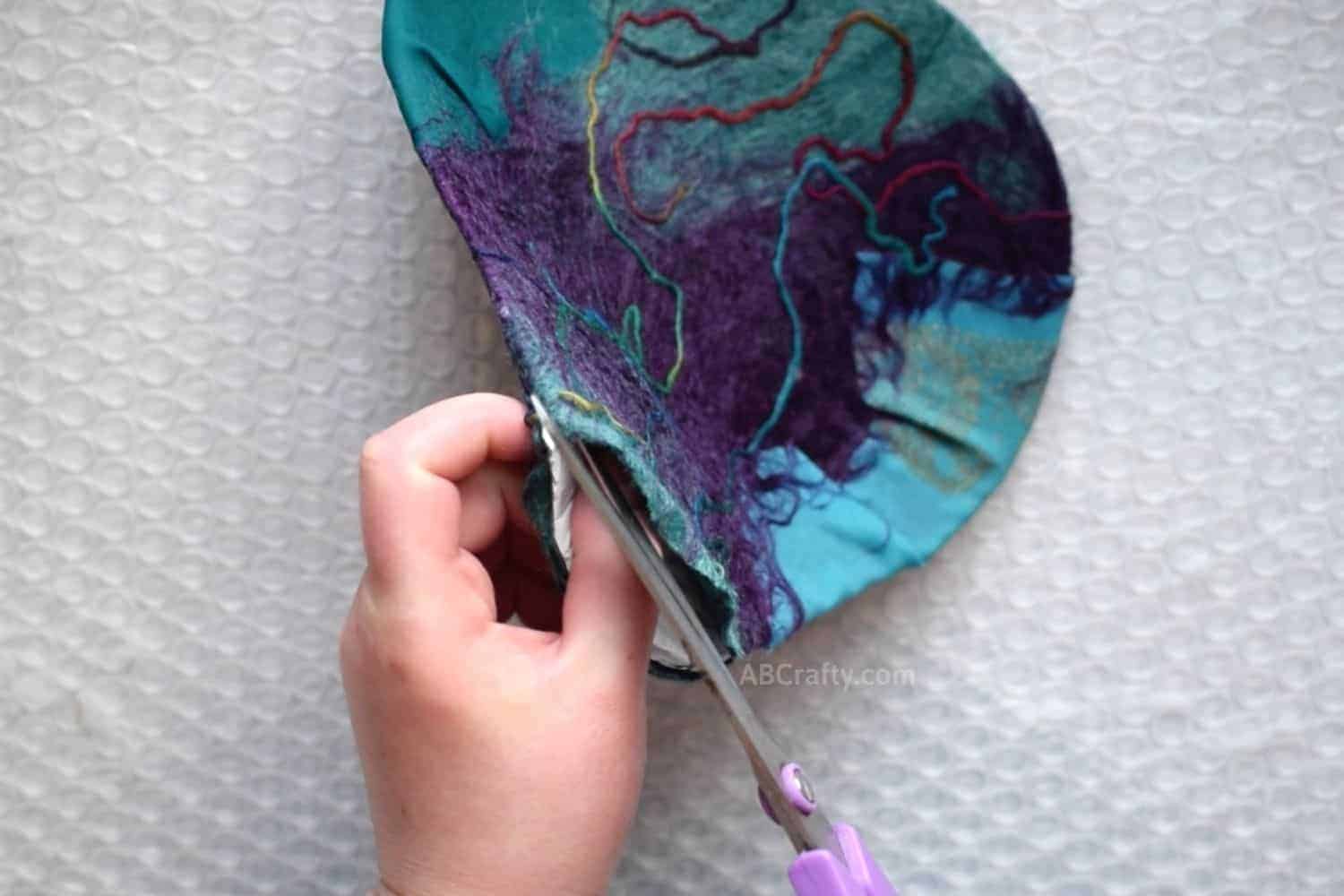
Pull the resist out of the felt.

Get your hands nice and soapy and rub the inside of the coin pouch. You want to create another layer of felted skin. I find it can be easier to fold it inside out and rub from the outside.

At this point is when I like to use a wooden dowel to roll. Just as with the pool noodle, be sure to give it a quarter turn after 25 rolls.
Check it after each 100 rolls and put your hand inside to ensure the inside isn’t felting to itself. Continue to roll from all directions.
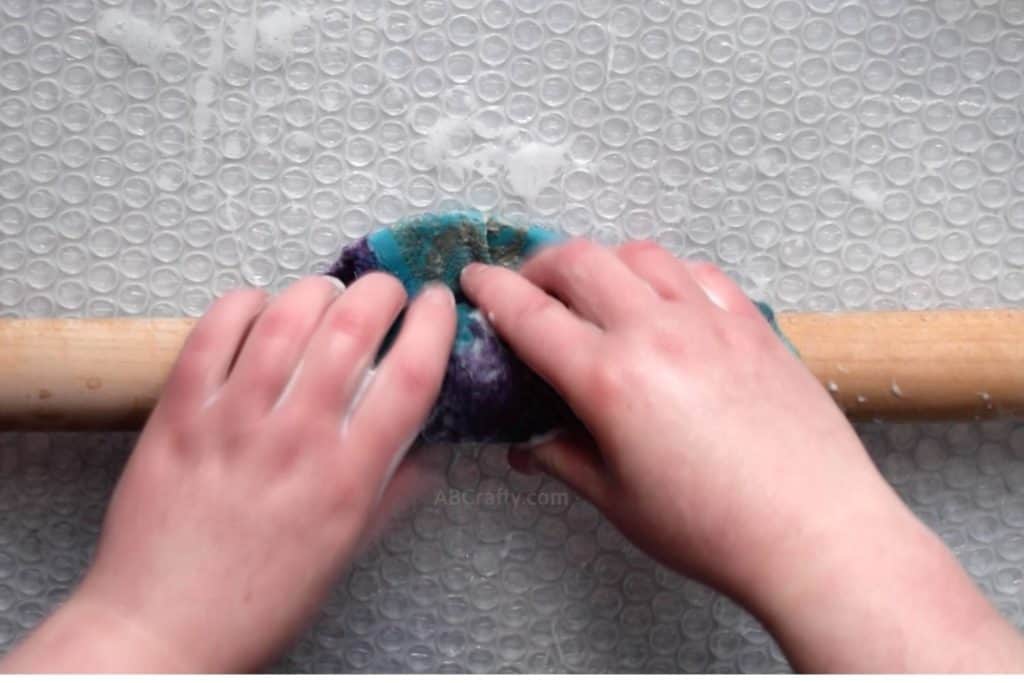
Open up the pouch and flatten it on its side. This will help so there isn’t a crease forming along the edge. Continue the rolling process.

With enough rolling the fibers will felt together and the coin pouch will shrink down.
Once it’s getting close to the size you want, you can start shaping it so it’s more round. To do so, put your fist inside the change purse and rub from the outside.

At this point it’s just about getting the change purse to the right size. You want to make sure the top matches the size of the purse clasp. If you need just certain parts to shrink down, you do what’s called “spot fulling.” Roll that one part in the direction you want it to shrink.

After enough felting and fulling (the name for the final stage of the felting process where all the fibers come together to form a solid piece of fabric), you’ll have a nice little soapy coin pouch.
Rinse the Felted Wool Purse
Rinse it thoroughly with warm water until it doesn’t feel soapy and the water runs clear. You can also “shock it” by alternating between hot and cold water. Shocking the fibers can also sometimes help felt the wool.
After it’s rinsed, let it soak in warm water that has a splash of vinegar added. The reason for this is wool is naturally slightly acidic, but when we add soap to it, it brings down the acidity. Adding vinegar to it brings back some of the acidity, bringing the shine back to the wool and giving it a bit more durability.
Once it’s soaked, let it dry. You can gently squeeze out the water, but don’t rinse it as you want to keep some of the vinegar in it.

Sew the kiss clasp onto the felted change purse
Now that you’ve made a felted coin pouch, it’s time to make it into a felted coin purse.
To sew the coin purse clasp (this is the one I’m using), begin by threading a needle with embroidery thread. I like to use a color that matches the colors of the wool purse. Tie the end into a knot.
Push your handmade felt all the way into the clasp. Start sewing on the second hole of the clasp, coming from inside the wool purse. Go back down through the first hole.

Go back down through the first hole. Then come back up through the third hole and back down through the second.
Continue in this pattern, coming up through the next hole and back through the one before.

When you get to the end, tie the embroidery thread into a knot. Cut off the excess thread.

Repeat the same process on the other side of the clasp. And if you want to turn it into a small coin purse keychain, then you can attach a keychain onto the loop of the clasp.
Your handmade felted coin purse is now finished and ready to use! I have made several of these coin pouches – it has become my go to felting project. Relative to other wet felting and nuno felting projects, it’s quick and easy and makes for a beautiful handmade gift.
Get the latest DIY tutorials, reviews, and crafting updates
You'll never be spammed and can unsubscribe at any time


More Handmade Felted Wool Coin Purses
Here are some more examples of DIY coin purses I’ve made via wet felting. Like I said, it’s become kind of my go to felting project and a fun way to play with new felting fibers and fabrics.


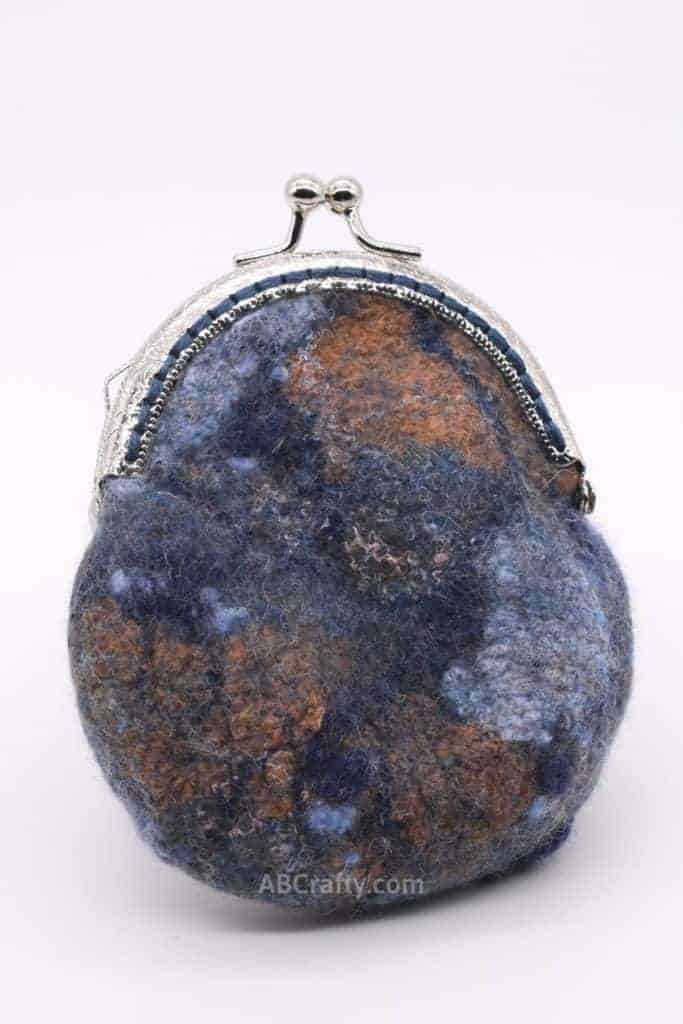

More Felting Projects and Other Fiber Arts Crafts
- Wet Felted Tiny Hat
- Needle Felted Catnip Cat Toys
- Wet Felted Venetian Mask
- Masquerade Mask Using Wet Felted Fabric
- Dye Silk with Lollipops to Use in a Nuno Felting Project
- Reversible Hat Made on a Knitting Machine
- How to Blend Your Own Wool with a Drum Carder
- Ultimate Guide to Wet Felting to learn different felting techniques

Handmade Felted Coin Purse
Materials
- Resist Material This can be any flexible non-porous material. I personally like to use the Amazon packing material for this as well
- 0.5 oz Wool Fiber Choose one color or multiple! I used merino. Make sure whatever wool you use is NOT labelled as “SuperWash” – this is treated so that it doesn’t felt
- Sari Silk Fabric Optional
- Silk Yarn Optional
- Coin Purse Clasp
- Embroidery Thread The color should match the wool
Equipment
- Bubble Wrap
- Mesh Fabric
- Olive Oil Soap
- Pool Noodle
- Towel
- Wooden Dowel
- Embroidery Needle
Instructions
Layer the wool fiber over the resist
- Pull off a small amount of fiber and lay it in one direction on top of the resist. (You can download the free resist template here)
- Continue laying down fiber in the same direction across one side of the resist. Let a little bit of the fiber lay over the edge as you want some to wrap around the edge.
- After you have your first layer of wool, start laying down the fiber in a layer perpendicular to the first. Again, make sure some hang over the edge.
- After you’ve completed your 2 perpendicular layers, take your mesh fabric and place it over the wool. Wet the wool with hot water that has olive oil soap added to it. Gently press the water in and air out with your hands.
- Grab one side, tucking in the fiber and carefully flip it over. As you flip it over, remove the mesh netting. Once on the opposite set, go around the edge and pull the wisps towards the middle.
- Start layering the wool on this side. You’ll do the same as you did on the other side. Start with the wool in the same direction as you did on the first side and then add a second layer perpendicular to the first.
- Just as with the first side, cover it in the mesh fabric and add the soapy water. Press the water in and air out. Flip it over and pull the wisps to the middle.Then repeat the entire process so that you have 4 total layers of wool on each side.
Add Embellishments
- Add the sari silk pieces and then small pieces of wool along the edge to help it felt.
- Add the yarn in a swirling pattern. You typically will not need to add additional wool on top of it. Fold the elements on to the other side and add additional elements onto that side.
Felt the Wool
- Get your hands wet and soapy using the olive oil soap and VERY gently rub along the top of the mesh.
- Continue this process on both sides until the embellishments are staying in place. Occasionally lift up the mesh to make sure the fiber and added elements are not sticking to it.
- Keep the mesh over the project and place the pool noodle on top on one side of the bubble wrap you’ve been working on. Roll it all up around the pool noodle. Roll it on all sides and from all sides.
- Lightly pinch the fibers. If they lift together as one then it’s ready. If the fibers are still separate then you need to roll more.
- When you start feeling the coin bag shrink down and the resist becoming too small, it’s time to remove the resist. Cut along the small top curve.
- Pull the resist out of the felt.
- Get your hands nice and soapy and rub the inside of the coin pouch. You want to create another layer of felted skin.
- Roll the partially felted coin purse from all directions and in all directions, just like with the pool noodle
- Once it’s getting close to the size you want, you can start shaping it so it’s more round. To do so, put your fist inside the change purse and rub from the outside.After it's the right size and shape rinse it out and let it dry.
Sew on the Coin Purse Kiss Clasp
- Start sewing on the second hole of the clasp, coming from inside the purse. Go back down through the first hole.
- Continue in this pattern, coming up through the next hole and back through the one before.
- When you get to the end, tie the embroidery thread into a knot. Cut off the excess thread.
- Repeat the same process on the other side of the clasp. Then your felted coin purse is complete!






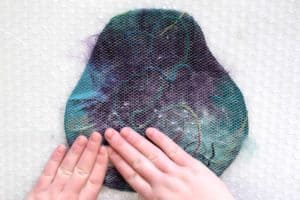








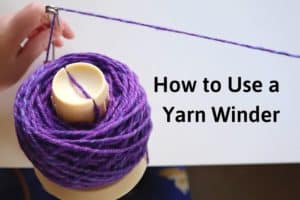


2 thoughts on “Wet Felted Coin Purse and Free Pattern”
I love this so much. Thank you for sharing your work!
Thanks so much! Glad you like it 😀